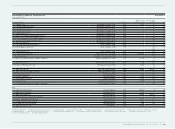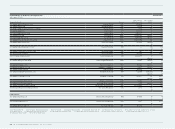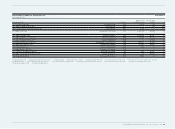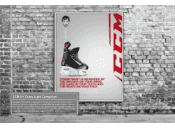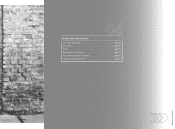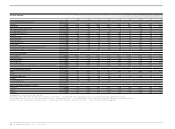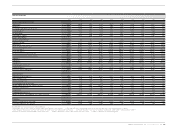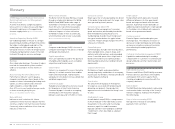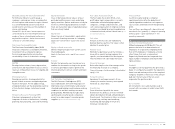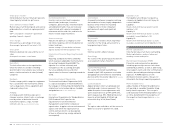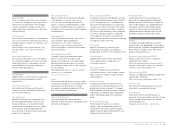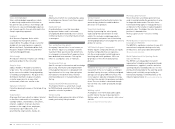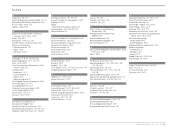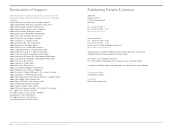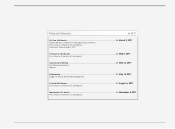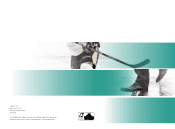Reebok 2010 Annual Report Download - page 243
Download and view the complete annual report
Please find page 243 of the 2010 Reebok annual report below. You can navigate through the pages in the report by either clicking on the pages listed below, or by using the keyword search tool below to find specific information within the annual report.
Additional Information Glossary 239
N
Natural hedges
Offset of currency risks that occurs naturally
as a result of a company’s normal operations,
without the use of derivatives. For example,
revenue received in a foreign currency and
used to pay known commitments in the same
foreign currency.
Net borrowings
Portion of gross borrowings not covered by the
sum of cash and short-term financial assets. If
a negative figure is shown, this indicates a net
cash position.
Net borrowings = short-term borrowings + long-
term borrowings – cash – short-term financial
assets.
Non-controlling interests
Part of net income which is not attributable to
the reporting company as it relates to outside
ownership interests in subsidiaries that are
consolidated with the parent company for
financial reporting purposes.
O
OHSAS 18000
OHSAS 18000 is an international occupational
health and safety management system
specification.
ÖKO-Tex Standard 100
An international testing and certification
system for textiles, defining and limiting the
use of certain chemicals.
Operating lease
Method of leasing assets over periods less
than the expected lifetime of those assets.
An operating lease is accounted for by the
lessee without showing an asset or a liability
on his balance sheet. Periodic payments
are accounted for by the lessee as operating
expenses for the period.
Operating overheads
Expenses which are not directly attributable
to the products or services sold, such as
costs for sales, marketing overhead costs,
logistics, research and development, as well
as general and administrative costs, but not
including costs for promotion, advertising and
communication.
Operating profit
Profit from operating activities after cost of
sales and other operating expenses.
Operating profit = gross profit + royalty and
commission income + other operating income –
sales working budget – marketing working budget –
operating overheads.
Operating working capital
Company’s short-term disposable capital
which is used to finance its day-to-day
business. In comparison to working capital,
operating working capital does not include
non-operational items such as cash, financial
assets and taxes.
Operating working capital = accounts receivable +
inventories – accounts payable
see also Working capital.
Option
Financial instrument which ensures the right
to purchase (call option) or to sell (put option)
a particular asset (e.g. shares or foreign
exchange) at a predetermined price (strike
price) on or before a specific date.
P
Performance business
In the sporting goods industry, business
related to technical footwear and apparel, used
primarily in doing sports.
Price-earnings ratio (P/E)
A company’s share price divided by its current
or future diluted earnings per share. The P/E
ratio is used by investors as a fundamental
measure of the attractiveness of a particular
security versus other securities or the overall
market. It is usually more useful to compare
P/E ratios of one company to other companies
in a similar industry. In general, a high P/E
ratio suggests that investors are expecting
higher earnings growth in the future compared
to companies with a lower P/E.
Price points
Specific selling prices, normally using
“psychological” numbers, for example a
product price of US $ 99.99 instead of US $ 100.
Private investor
Individual who invests his/her own money
in the capital market, as opposed to an
institutional investor.
Private placement
Placement of debt securities directly to
institutional investors, such as banks, mutual
funds, insurance companies, pension funds
and foundations.
Product licensees
Companies that have the authorisation to
use the name of a brand or business for the
production and sale of products. For adidas,
licensed products include cosmetics, watches
and eyewear, for Reebok, fitness equipment
and for TaylorMade-adidas Golf, bags and
gloves.
Promotion partnerships
Partnerships with events, associations,
leagues, clubs and individual athletes. In
exchange for the services of promoting the
adidas Group, the party is provided with cash
and/or promotional material.
Push-pull model
A push-pull system in the retail business
describes the supply and demand dynamic
between retailers and consumers. Under the
push model, products are supplied based on
anticipated customer orders (speculative)
whereas in a pull model system goods are
supplied based on consumer point-of-sale
demands and actual market sales trends.
R
Regions
The adidas Group distinguishes seventeen
markets which are aggregated into six regions:
Western Europe, European Emerging Markets,
North America, Greater China, Other Asian
Markets and Latin America.
Return on capital employed (ROCE)
Measure of the returns that a company is
realising from its capital.
ROCE = (income before taxes + financial result ) /
(average of shareholders’ equity + non-controlling
interests + total net borrowings) × 100.
Return on equity (ROE)
Indicator of company profitability related to the
shareholders’ financing.
ROE = (net income / shareholders’ equity) × 100.
Risk-free rate
Rate of return to be expected on a risk-less
investment, e.g. government bonds.
Risk premium
Extra return that the overall market or a
particular stock must provide over the risk-free
rate to compensate an investor for taking a
relatively higher risk.
Risk premium = market risk – risk-free rate.


